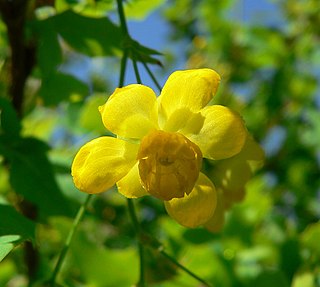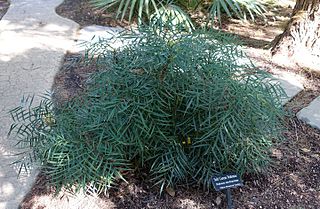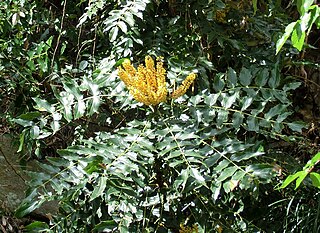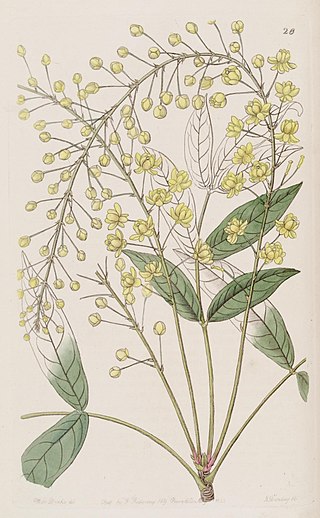
Mahonia is a formerly accepted genus of approximately 70 species of shrubs or, rarely, small trees with evergreen leaves in the family Berberidaceae, native to eastern Asia, the Himalaya, North America, and Central America. They are closely related to the genus Berberis and as of 2023 the majority of botanical sources list it as a synonym for Berberis.

Berberis fremontii is a species of barberry known by the common name Frémont's mahonia.

Berberis fortunei is a species of shrubs in the family Berberidaceae, the barberry family, described as a species in 1846. It is endemic to China, found in the provinces of Chongqing, Guangxi, Guizhou, Hubei, Hunan, Jiangxi, Sichuan, Taiwan, and Zhejiang. It is grown as an ornamental in many lands, with common names including Chinese mahonia, Fortune's mahonia, and holly grape.
Berberis pimana is a species of the genus Berberis in the family Berberidaceae. It is native to a mountainous region of the Sierra Madre Occidental in the Mexican states of Chihuahua and Sonora.
Berberis moranensis is a shrub in the genus Berberis in the family Berberidaceae. Because of its compound leaves, some botanists place it in the genus Mahonia. It is native to forested regions of the mountains of Mexico from Sinaloa and Guanajuato to Oaxaca. Berberis moranensis has thick waxy leaves, yellow flowers, and purple berries. This species is closely related to Berberis pimanaJ.E. Laferr. & J.S. Marr.
Berberis chochoco is an evergreen shrub or small tree up to 9 m (30 ft) tall, in the genus Berberis, family Berberidaceae. It is native to mountainous regions of northeastern Mexico, in the states of Nuevo León, Veracruz, and San Luis Potosí.

Berberis haematocarpa, Woot. with the common names red barberry, red Mexican barbery, Colorado barberry and Mexican barberry, is a species in the Barberry family in southwestern North America. It is also sometimes called algerita, but that name is more often applied to its relative, Mahonia trifoliolata.
Berberis wilcoxii is a shrub native to Arizona, New Mexico and Sonora. It is up to 2 m tall, with pinnately compound leaves of 5-7 leaflets, densely clustered racemes and ovoid berries up to 10 mm long. It is generally found in rocky canyons in mountainous areas at an elevation of 1700–2500 m.
Berberis muelleri is a shrub with compound leaves, native to the Mexican State of Nuevo León.
Berberis pumila is a species of shrub native to Oregon and northern California. It is found in open woods and rocky areas at an altitude of 300–1,200 m (980–3,940 ft) in the Coast Ranges, the northern Sierra Nevada and the southern Cascades, often on serpentine soils.

Berberis gracilis is a plant species native to the Mexico, widely distributed from Tamaulipas to Oaxaca.

Berberis eurybracteata is a species of shrub in the Berberidaceae described as a species in 1901. It is endemic to China.

Berberis gracilipes is a shrub in the family Berberidaceae, first described in 1887. It is endemic to China, native to the Sichuan and Yunnan Provinces.

Berberis napaulensis Nepali: जमाने मान्द्रो is a shrub in the family Berberidaceae described as a species in 1821. It is native to China and the Himalayas. This species is used medicinally throughout the Sikkim Eastern Himalayas.
Berberis schochii is a shrub in the Berberidaceae described as a species in 1913. It is endemic to China, known from the provinces of Guizhou and Sichuan.
Berberis polyodonta is a shrub in the Berberidaceae described as a species in 1901. It is native to Assam, Myanmar, and southwestern China.

Berberis tenuifolia is a shrub in the family Berberidaceae described as a species in 1838. It is native to Cuba and Mexico.
Berberis paxii is a shrub in the Berberidaceae described as a species in 1901. It is endemic to the State of Hidalgo in eastern Mexico.
Berberis eutriphylla is a species of shrub in the Berberidaceae described as a species in 1901. It is endemic to northern and central Mexico, from Coahuila to Mexico State.
Berberis standleyi is a shrub in the Berberidaceae described as a species in 1952. It was published with the name Mahonia glauca, a very different plant from Berberis glauca. Thus if one desires to consider Berberis and Mahonia as one genus instead of two, it is necessary to use a different name, i.e. Berberis standleyi.








